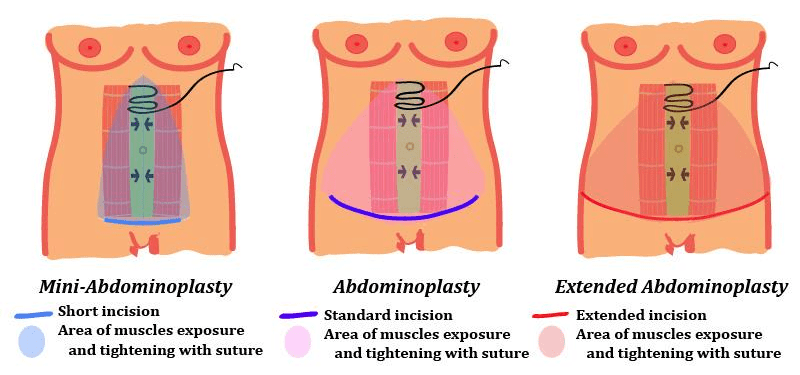TUMMY TUCK
WHY IS IT PERFORMED?
Pregnancy/C-Section: Because of the way that pregnancy stretches the skin and separates the abdominal muscles, diet and exercise can be inadequate in tightening the abdominal area after childbirth. Muscle tone and skin elasticity may be poor, especially after multiple pregnancies. Standard Tummy tuck surgery restores the pre-pregnancy figure, sometimes incorporating liposuction to remove the stubborn excess fat that can remain after childbirth.
Significant Weight Loss: People who have lost a significant amount of weight may enjoy much improved health, but the weight loss can also have undesirable aesthetic effects. Loose, sagging skin and overstretched abdominal muscles can make a person feel nearly as self-conscious about his or her body as a higher weight.

The Aging Process: As a person ages, the skin loses some of its natural elasticity and the muscles gradually weaken. The aging process often has a pronounced impact on the abdominal region, resulting in a flabby, sagging midsection. For some, the loss of definition in the stomach area is a source of self-consciousness, as they begin to appear older and less fit than they feel. In such cases, a tummy tuck can have a rejuvenating effect on the entire body. Thanks to the tightening and streamlining of the abdominal area, post-tummy tuck patients enjoy looking younger and healthier.
Genetics: The overall shape of one’s body and the areas where pockets of fat tend to accumulate are largely determined by genetics. For some people, the bothersome flab that gathers in the abdominal region may not be reflective of their true level of activity and fitness. Even a person in his or her 20s, 30s, or 40s may be genetically predisposed to stubborn abdominal roundness.

INVOLVED RISKS:
Infection: this may require treatment with antibiotics.
Hematoma (bleeding under the skin): This may need to stop the bleeding and drain the area.
Seroma: A buildup of fluid around the wound that may need to be drained with a needle and syringe.
Unusually red or raised scars may take several months to fade.
Problems with the healing of your wounds: they can slow down your recovery and cause more noticeable scars tingling, burning, numbness, or pain when touching the skin.
Changes in skin sensitivity: The repositioning of abdominal tissues can affect the nerves in the area and in very few occasions in the upper part of the thighs, this disappears a few months after surgery.
HOW THE PROCEDURE IS PERFORMED? (TECHNIQUE)
Incisions
Standard tummy tuck involve one incision along the front of the abdomen from one hip bone to the other. All incisions are carefully planned prior to surgery to improve the chances that the resulting scars will be easily hidden beneath underwear, bikinis, and other swim wear.
Naval Reattachment and Sculpting
Most tummy tucks involve changing the position of the naval in order to make the tightened skin of the abdomen appear more natural. To detach the navel, a second vertical incision is made across the abdomen’s central section. Our surgeon will create a more appealing result, another small incision is made to either reattach your existing naval or artificially sculpt a new one. Naval reattachment and naval sculpting are surgical art forms.
Tightening of the Muscles
It is common for the abdominal muscles to become more lax as the patient ages. During abdominoplasty surgery, our surgeon will tight sagging abdominal muscle mass, as well as remove packets of excess fat and skin from the stomach area. Through the surgical incisions, the skin is separated from the abdominal walls. The abdominal muscles are pulled closer together and stitched into a position that will give them a more toned appearance. Tightening the abdominal muscles also tends to narrow the waistline.
Skin Removal
Following the tightening of the abdominal muscles, the skin is stretched downward, and excess skin is trimmed away. Sometimes liposuction is used to remove any unwanted fat pockets before the skin is pulled taut.
Closing the Incisions
When the abdominoplasty surgery is complete, the skin is sutured together using surgical stitches. With the stitches in place, your skin cells will coalesce at the site of incision, closing the wound naturally over time. A surgical drain will also be inserted at the site of incision at the same time that the stitches are put into place. Surgical drains speed up the healing process and often alleviate pain from the buildup of fluids beneath the skin.
WHAT TO EXPECT AFTER SURGERY:
The results of a tummy tuck are best seen after 6 weeks when all the swelling has subsided. It can take over a year for the scars to fully heal.
Under the proper conditions, the results of an abdominoplasty surgery can last for many years. Exactly how long you maintain your abdominoplasty results depends on how well you take care of your body following surgery. Living a healthy and active lifestyle will prolong your tummy tuck benefits for at least a decade after your initial surgery and probably longer.
HOW IS THE RECOVERY?
Every patient will heal differently after and It depends of the type of tummy tuck procedure that was performed. You will be given a course of painkillers and antibiotics to take following surgery and you will need to wear your surgical garment for 6 weeks following your procedure to help aid any fluid retention and support you whilst you heal. You may feel tight in their stomach for the initial week following surgery but this should get better as the swelling subsides, you should get up and take regular walks throughout the day. You should avoid lifting anything that could make you strain for 6 weeks which includes children, heavy bags and vacuum cleaners for example.
Patients can look to return to work after 2-3 weeks, however this will depend on their job rol, and should wait 6-8 weeks before returning to exercise,
